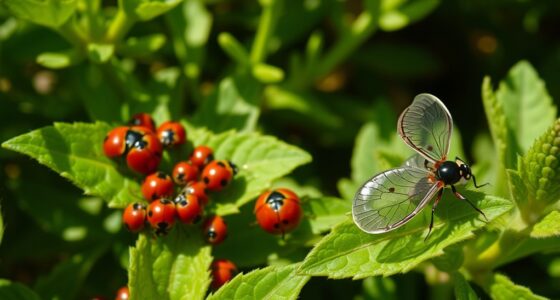Espalier fruit trees typically produce about 10 to 20 pounds of fruit per year per tree, with yield per linear foot influenced by training pattern, rootstock, and variety. Properly spaced, pruned, and supported trees using horizontal cordons or fan patterns can optimize light and air flow, increasing fruit density. Keep in mind that canopy size and spatial limits affect total yield. If you want detailed tips, exploring further will help you maximize your espalier’s productivity.
Key Takeaways
- Dwarf espalier trees typically yield 10–20 pounds annually, with about 0.25 to 0.5 bushels per tree.
- Fruit production per linear foot depends on training pattern, branch density, and canopy management.
- Horizontal cordons increase fruit density along branches, boosting yield per foot of trained structure.
- Proper pruning and spacing optimize light exposure, thereby increasing fruit yield per linear foot.
- Spatial constraints from horizontal training limit total canopy volume and overall yield per unit length.
Estimating Fruit Yield Based on Tree Size and Spacing

Estimating fruit yield based on tree size and spacing is essential for maximizing your espalier orchard’s productivity. With semidwarf trees needing at least 10 feet of wall space and dwarf varieties about 6 feet, you can plan your layout for ideal fruit production. A mature espalier apple with 6-foot lateral arms can produce fruit across 60 linear feet of branches, with fruit spaced as close as 6 to 8 inches apart. Proper spacing ensures better light exposure and air circulation, boosting yield and fruit quality. Training and pruning help increase fruit density per foot, especially in trees on dwarf or semi-dwarf rootstocks. Keep in mind, overcrowding reduces flowering and fruit size, so maintaining appropriate distances is key for consistent high yields. Additionally, proper pruning techniques and seasonal management can significantly influence fruit production and quality over the years. Adequate light exposure is crucial for optimal photosynthesis and fruit ripening, further enhancing your orchard’s productivity.
Impact of Rootstock and Variety on Production Density
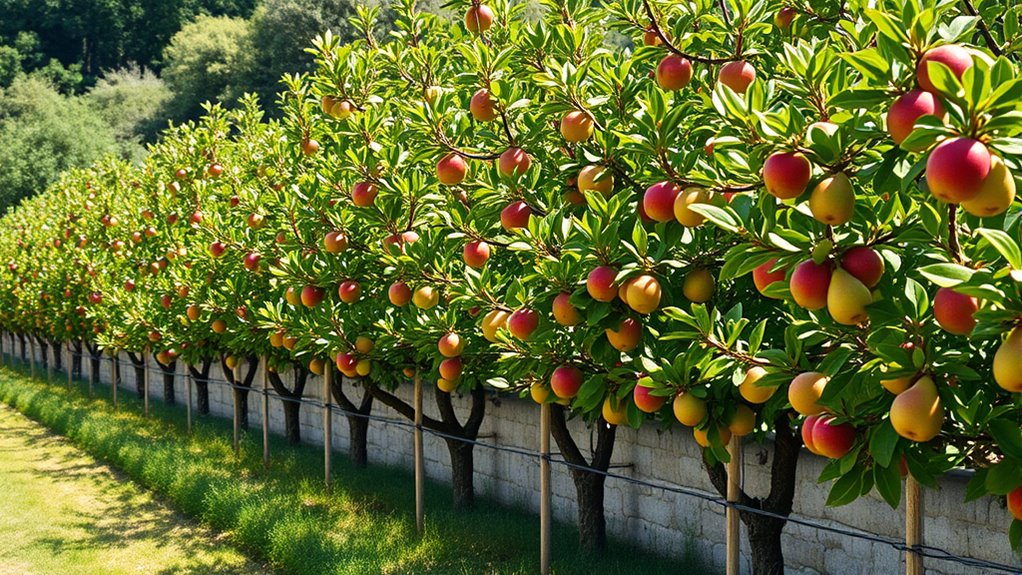
The choice of rootstock and fruit variety directly influences how densely you can plant and how much fruit each espaliered tree produces. Dwarfing rootstocks like M9 and M26 for apples reduce tree size, allowing you to plant more trees per linear foot and increasing overall production density. Semi-dwarf rootstocks such as MM111 and MM106 strike a balance between size and yield, affecting how tightly you can arrange your trees. Different rootstocks impact tree vigor and fruit production, which influences yield per linear foot. Additionally, the compatibility between rootstock and variety affects overall tree health and productivity, ensuring optimal fruit set and yield. Similarly, fruit varieties have inherent growth patterns and yield characteristics that affect density. Selecting compatible rootstocks and varieties ensures ideal space utilization and maximizes fruit production along your espaliered rows. Accurate yield estimation is essential for planning and optimizing your orchard layout effectively.
Training Patterns and Their Effect on Fruit Output per Foot

Different espalier training patterns markedly influence fruit yield per linear foot by shaping branch orientation and light exposure. Horizontal cordons encourage lateral fruiting spurs, maximizing sunlight and increasing fruit density along each foot of the structure. Fan and candelabra patterns create larger canopies, but they require more space and careful pruning to prevent overcrowding, which can reduce fruiting efficiency. Uniform branch spacing ensures even light penetration, boosting photosynthesis, fruit size, and quality. The structural design helps distribute fruit loads evenly, reducing breakage and supporting consistent yields. By optimizing branch angles and canopy architecture, these patterns enhance light interception and airflow, leading to healthier trees and higher productivity per linear foot. Proper training directly correlates with improved fruit output and quality. Additionally, understanding the impact of training patterns on light exposure can help gardeners tailor their pruning techniques for optimal fruit production.
Typical Fruit Production Metrics for Mature Espalier Trees
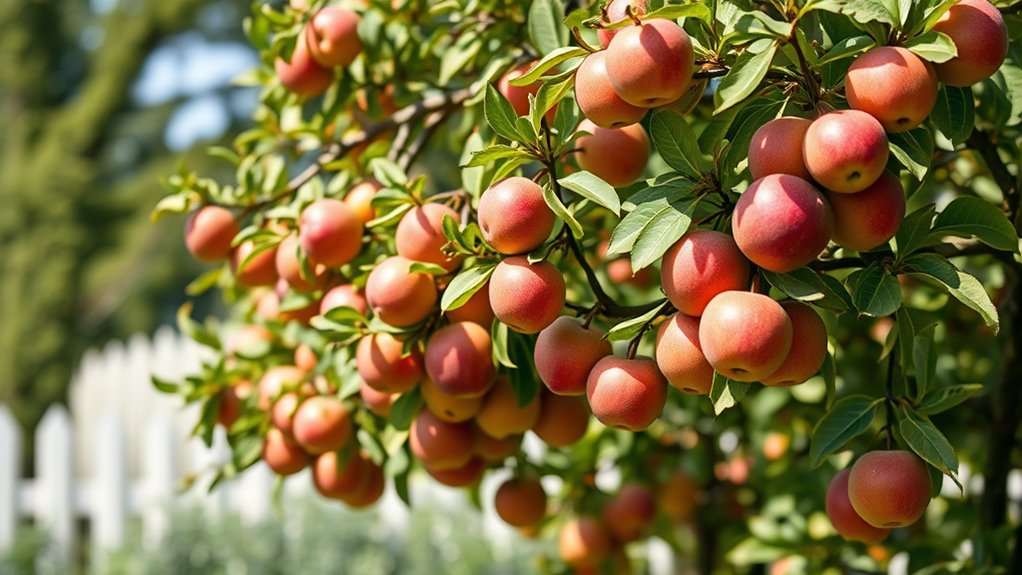
Understanding how much fruit a mature espalier tree can produce helps you plan for harvests and set realistic expectations. While yields vary based on tree size, variety, and care, you can generally expect a dwarf espalier to produce around 1/4 to 1/2 bushel annually. By examining these metrics, you’ll gain a clearer picture of your tree’s fruiting potential and how to optimize it. Additionally, factors like tree age and health significantly influence the actual yield you can expect from your espalier, and proper nutrient management can help maximize fruit production.
Yield per Tree
Mature espalier fruit trees typically produce between 10 and 20 pounds of fruit annually under ideal conditions. Your tree usually begins fruiting within 2 to 4 years, with yields increasing as it matures. Peak production occurs around 5 to 10 years, especially with proper pruning and training. The choice of rootstock influences how quickly your tree bears fruit and how much it produces. Dwarfing rootstocks promote earlier, manageable yields. The actual harvest depends on your tree’s health, variety, and maintenance practices. Regular pruning ensures a balance between vegetative growth and fruiting, maximizing your yield. Proper training and pruning techniques are essential for achieving optimal production in espalier fruit trees. Remember, healthy, well-maintained espalier trees can sustain consistent annual production, making them an efficient and productive addition to your garden or small space. Additionally, understanding AI in agriculture can help optimize fruit production through better monitoring and management techniques.
Fruit Quantity Estimates
Espalier fruit trees can produce impressive yields when properly established and maintained. On dwarf rootstocks, you can expect about 10 to 20 pounds of fruit per linear foot annually under ideal conditions. Semi-dwarf trees tend to yield more, scaling proportionally with their increased vigor and space requirements. The actual harvest depends heavily on the variety, rootstock, and sunlight exposure; full sun (6+ hours daily) boosts fruit size and quantity. Training branches horizontally in tiered systems maximizes production per linear foot, while intensive pruning maintains vigorous fruiting wood. Generally, mature apple and pear espalier trees yield between 10 and 30 pounds per linear foot. Although less common, stone fruits like peaches and cherries may produce lower yields, while dense small-fruit bushes offer proportionally smaller but abundant harvests within limited linear space. Automation in agriculture technology is increasingly being used to monitor and optimize fruit production, further enhancing yields and efficiency.
Growing Conditions That Maximize Fruit Yield in Espaliers
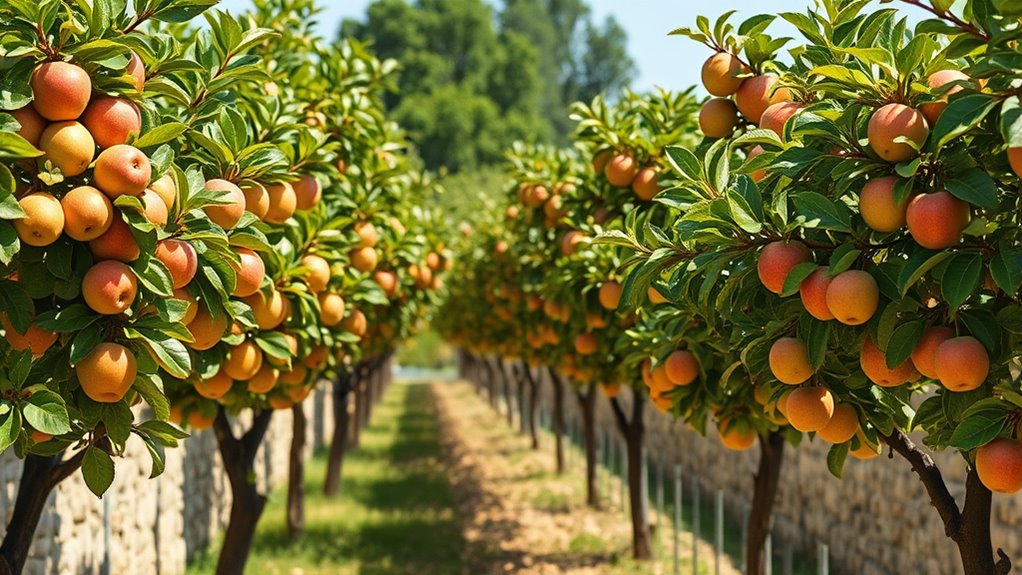
To get the most fruit from your espalier, you need to optimize sunlight, soil, and support. Make sure your trees face south and are against warm walls for maximum sun and heat, while the soil stays well-drained and fertile. Providing sturdy supports keeps branches in the right shape, encouraging healthy growth and higher yields. Historical use of espalier for frost protection highlights the importance of placement and environmental considerations for optimal productivity. Incorporating watering techniques that suit your plant type can further enhance fruit development and overall health.
Sunlight Exposure Needs
Achieving the highest fruit yields from espalier trees depends heavily on providing sufficient sunlight. You need to guarantee your trees get at least six hours of direct sunlight daily, with eight or more hours being ideal for maximum productivity and flavor. Position your trees on south-facing walls or structures to maximize sun exposure and reflection. Plant along east-west lines for even light distribution, and give each tree about 8 feet of space to prevent shading from neighbors. Regularly prune to open the canopy, allowing sunlight to reach all branches. Increased sun exposure improves fruit size, color, and sugar content, while reducing disease risk. Monitor seasonal changes and adjust supports or remove obstructions to maintain ideal sunlight throughout the growing season.
Soil and Nutrients
Ensuring your espalier fruit trees thrive requires paying close attention to soil and nutrient conditions. Keep soil pH between 6.0 and 6.5 to maximize nutrient availability; if it’s too low, lime can raise pH, while sulfur can lower it over time. Good drainage prevents waterlogging, which can harm roots—consider raised beds if needed. Avoid planting near large trees to reduce root competition. Regularly test soil and adjust with organic fertilizers or amendments based on results. Incorporate compost to enhance soil structure, moisture retention, and microbial activity, supporting healthy nutrient cycling. Monitor nutrient levels through soil and leaf testing, especially for nitrogen, potassium, calcium, and magnesium. Proper soil management ensures your trees develop strong roots, healthy growth, and abundant fruit production in your espalier setup.
Proper Tree Support
Have you considered how your espalier fruit trees are supported? Proper support is essential to maximize fruit yield and maintain structure. Use a sturdy, permanent framework like metal or treated wood, anchored securely to prevent sagging. Install horizontal wires or frameworks at regular intervals to guide branches and bear fruit weight. Regular maintenance, including tightening wires, keeps the structure strong as the tree grows. Training against walls or trellises can further enhance microclimates and support growth. Additionally, selecting weather-resistant materials ensures long-term durability of your support system. Here are key support tips:
- Choose weather-resistant materials for durability.
- Anchor posts firmly to prevent collapse.
- Space wires evenly for ideal branch training.
- Regularly inspect and tighten supports.
A solid support system ensures your espalier remains stable, promotes healthy growth, and increases fruit production per linear foot.
Limitations and Practical Considerations for Optimizing Yield
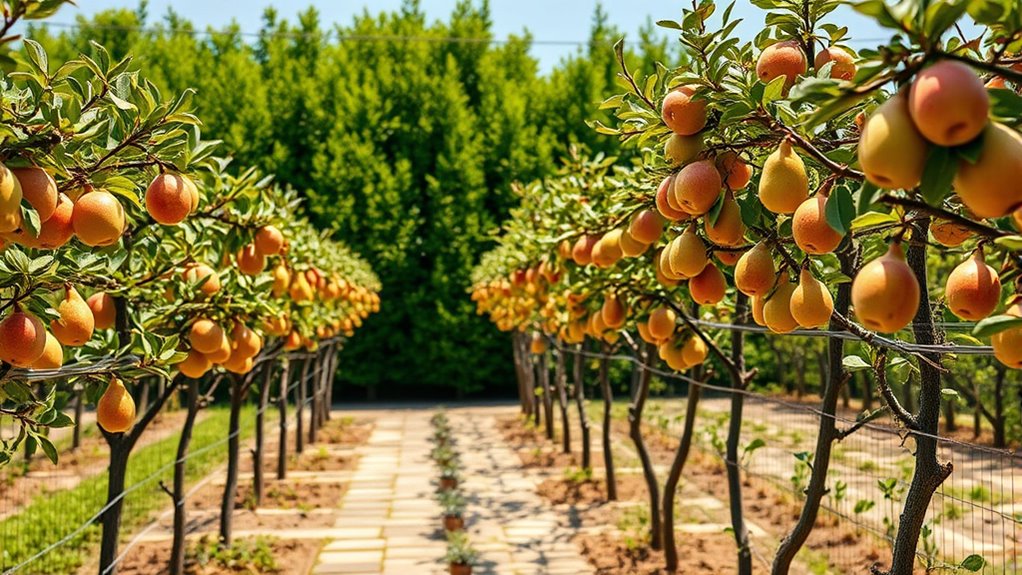
Optimizing yield in espalier fruit trees involves maneuvering several practical limitations. Estimating fruit quantity per tree is challenging because limbs vary greatly, and visual assessments are restricted by the tree’s three-dimensional structure. Sampling a few limbs often doesn’t reflect the full yield, though higher-density plantings with narrow canopies improve visibility. Spatial constraints from horizontal training limit canopy volume, potentially reducing total fruit compared to free-standing trees. Pruning is essential for shape and fruit quality but must be balanced; excessive pruning lowers yield, while improper timing can harm next season’s crop. Grafted multiple varieties add diversity but complicate yield predictions due to differing growth and fruiting patterns. Managing these factors ensures you maximize yield within space while maintaining healthy, productive trees. Understanding the growth patterns of different varieties helps in planning pruning and harvesting strategies to optimize overall yield. Additionally, employing proper orchard management techniques can further improve fruit production and tree health.
Frequently Asked Questions
How Does Pruning Influence Fruit Yield per Linear Foot in Espalier Systems?
Pruning directly impacts your fruit yield per linear foot by reducing the amount of wood with flower buds, which lowers total potential production. While it may decrease overall yield, pruning improves fruit quality, size, and plant health. It also shapes the tree for better light and air circulation, leading to larger, healthier fruits. Proper timing and technique guarantee you balance yield quantity with quality and long-term productivity in your espalier system.
What Is the Fastest Way to Increase Yield in Young Espalier Fruit Trees?
Ever wonder how to get more fruit from your young trees quickly? To boost yield fast, start by selecting flexible, early-yielding varieties like apples or pears. Prune aggressively to develop a strong framework and focus growth on lateral fruiting spurs. Tie branches horizontally for maximum light exposure, and prune regularly to encourage fruiting. Proper support, timely pruning, and choosing the right cultivars will help you see faster, better harvests.
Can Multiple Varieties Be Combined on One Espalier for Higher Total Yield?
You can definitely combine multiple varieties on one espalier to boost total yield. Grafting different fruit types onto a single tree maximizes space and allows you to harvest diverse fruits simultaneously. Properly managing pruning, branch spacing, and sunlight exposure helps each variety thrive. Plus, cross-pollination among compatible cultivars increases fruit set. Overall, a well-designed multi-variety espalier enhances productivity, extends your harvest season, and offers a more abundant, varied fruit supply.
How Does Fruit Thinning Affect Overall Yield per Linear Foot?
Think of fruit thinning as pruning a crowded garden—by removing some fruits, you give the remaining ones room to grow bigger and better. It might seem like you’re losing fruit, but in reality, you’re boosting the size and quality of what’s left. This balance keeps your yield per linear foot steady or even higher, promotes healthier trees, and ensures every fruit is a prize worth picking.
What Are Common Pitfalls That Reduce Yield in Home Espalier Orchards?
You often reduce yield in your home espalier orchard by neglecting proper pruning and maintenance, like not thinning fruit or managing growth. Poor site selection, such as planting too close or in shade, limits airflow and sunlight, lowering productivity. Using unsuitable tree varieties or planting too deep weakens roots. Additionally, ignoring pests, diseases, and environmental stresses hampers fruit development, ultimately decreasing your orchard’s overall yield and fruit quality.
Conclusion
By understanding how tree size, spacing, and training patterns influence yield per foot, you can turn a simple wall into a lush orchard. Imagine a single line of espalier bursting with fruit, each foot packed with promise, versus a sparse, underused trellis. With careful planning and ideal conditions, you’ll see your investment grow—fruitful and thriving—transforming a modest espalier into a productive masterpiece that maximizes every inch of space.
I’m Theodore, and I love tiny houses. In fact, I’m the author of Tiny House 43, a book about tiny houses that are also tree houses. I think they’re magical places where imaginations can run wild and adventures are just waiting to happen.
While tree houses are often associated with childhood, they can be the perfect adult retreat. They offer a cozy space to relax and unwind, surrounded by nature. And since they’re typically built on stilts or raised platforms, they offer stunning views that traditional homes simply can’t match.
If you’re looking for a unique and romantic getaway, a tree house tiny house might just be the perfect option.



